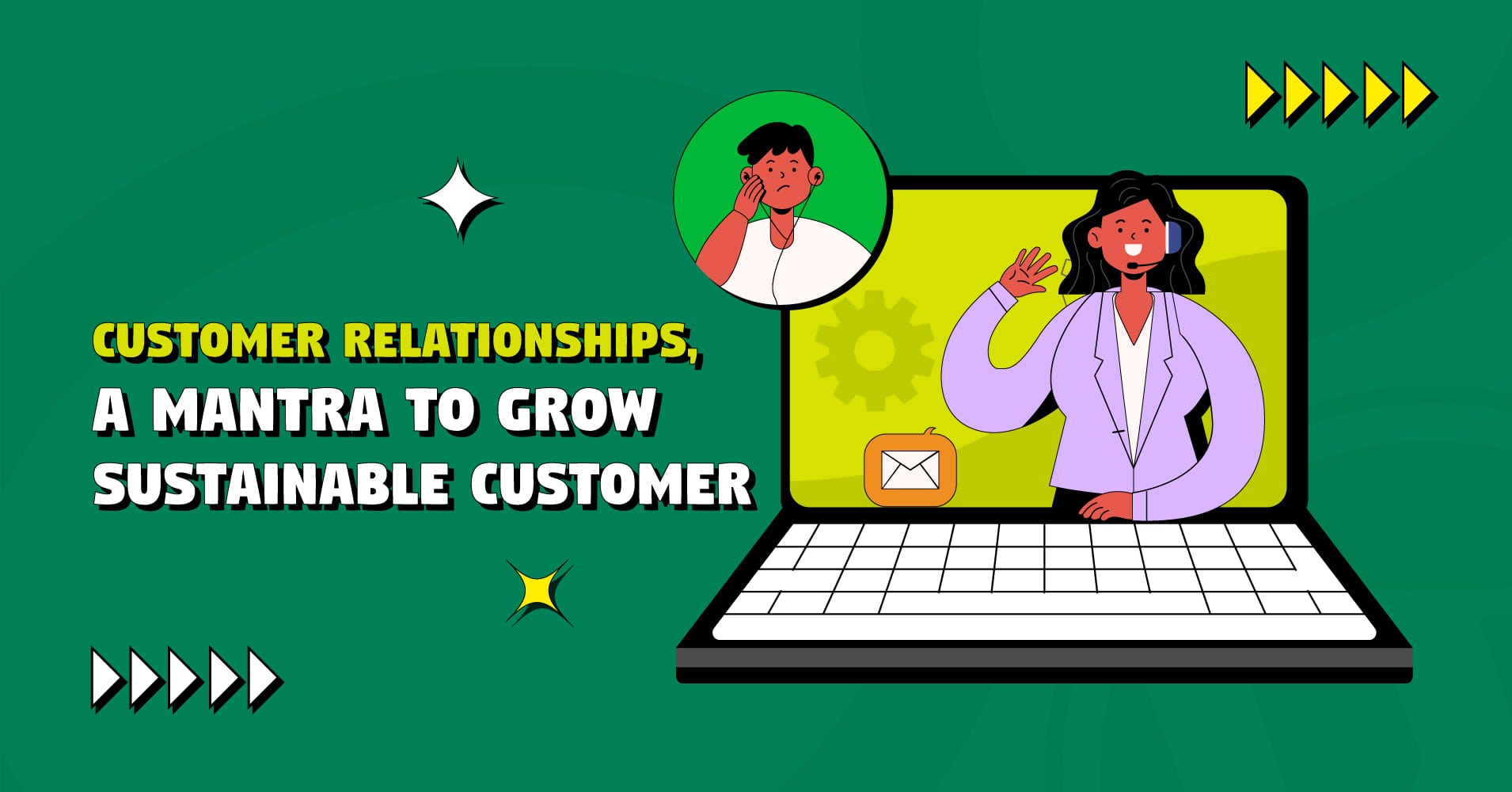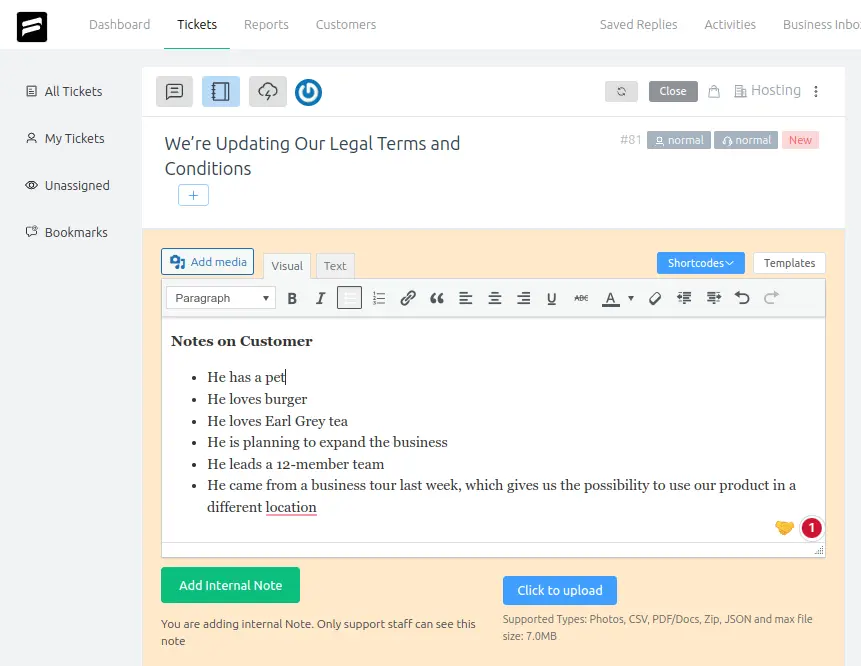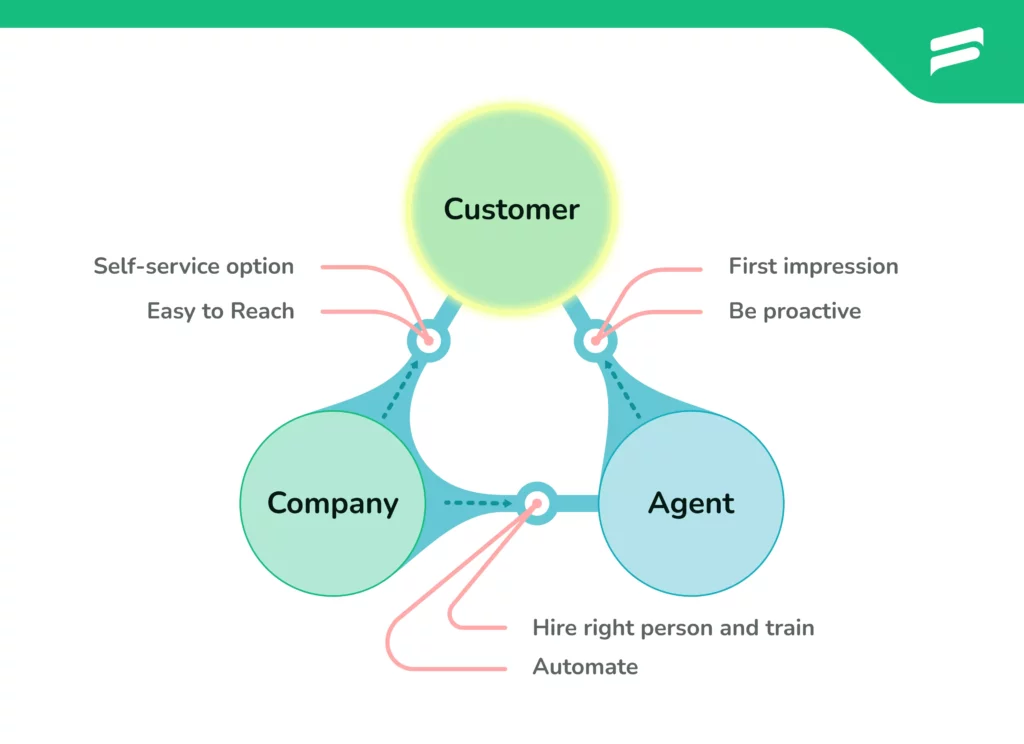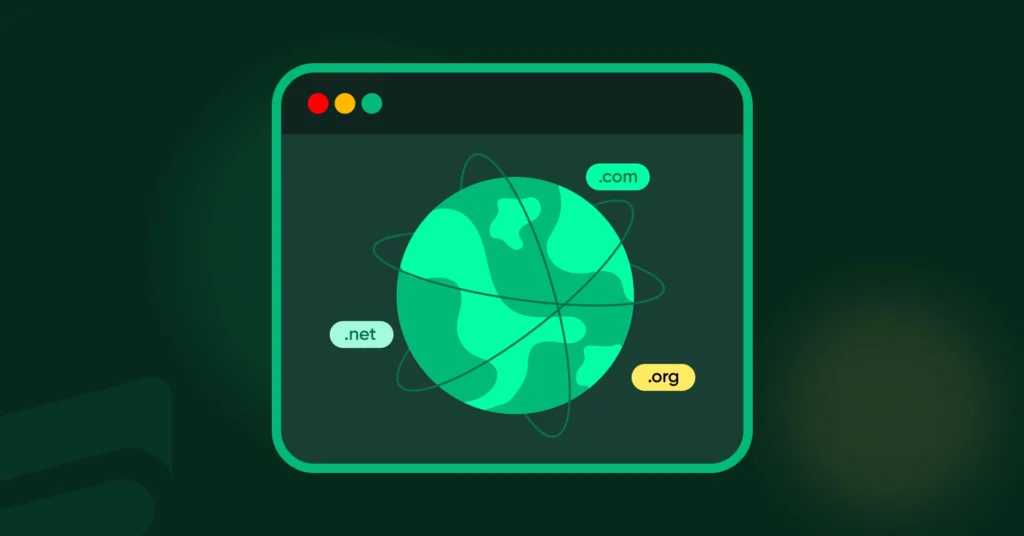
Customer Relationships, A Mantra To Grow Sustainable Customer Base
Businesses can grow their revenue by 4% to 8% if they can provide better customer service. Better customer service comes from personalized interaction. And personalization is possible by building better customer relationships.
Companies spend thousands of dollars on advertising. And there is no doubt it works. But nowadays, the conversion rate via ads is declining. We are all kinda sorta growing resistance towards ads.
Instead, people buy faster when it’s a suggestion from someone they know. In marketing terms, it’s called Word-of-mouth marketing. But people don’t just randomly suggest a product. You need to earn the trust and loyalty of that client.
To build trust and comfort about your service or product, you need a good relationship with your client. There are lots of companies that have a literal fan base because of a better client relationship.
Understanding customer relations
Before we get more into how to build customer relationships. Let’s zoom out a bit. Let us explain what is customer relationships.
What is customer relations?
Customer relations is establishing and maintaining interactions with empathy, knowledge, and value with current, future potential, and previous customers.
Every and any kind of interaction from a company with a client is responsible for relation buildup. Each department is responsible for this either directly or passively.
The journey of this relationship between the client and the company starts with the marketing team. Then passed it to the sales team. And finally, it got stuck to the support team to sustain.
In short, the entire customer support funnel system has to build and maintain a relationship with the customer. That means you all must be on the same page regarding customer interaction. We will discuss it more later in this article.
Importance of good customer relations
Now that we have an idea of what the customer relationship is. Let’s see what we’ll get from this on different levels.
- Repeating customer numbers will increase significantly.
- You can create customer loyalty or a dedicated fan base.
- This will give you a competitive advancement in the market.
- That will draw more and more new customers.
- It will increase positive brand awareness.
- And finally, everything will lead to increased revenue.
In our own experience, we have seen many customers return to us repeatedly. Just because we were able to build a good relationship with them.
Strategies for building strong customer relations
You have to start building a relationship with a customer from day one by understanding the sentiment. As we mentioned earlier, that usually begins with the marketing team. Hence, you have to have a strategic plan to maintain a consistent approach.

“It is so much easier to be nice, to be respectful, to put yourself in your customer’s shoes and try to understand how you might help them before they ask for help, than it is to try to mend a broken customer relationship.”
Mark Cuban
Without any plan, you will likely fail to interact effectively. And, It is a much harder job to repair a broken relationship with a customer.
So, let’s go through some strategic plans to build smooth customer relationships. Thus, make your customer feel special.
Customer relationship strategy
You have to understand that every company has a unique setup. We have listed these 5 strategies for building better client relations by considering different mindsets.
1. Communication is the key
Reach your customer and talk. The simplest mantra to build relations. Not just call and sell. Reach your customer to share knowledge and experience. Talk about their problems and try to give a solution.
Customer relationships are built over time, NOT overnight.
Show empathy
One of the key points for building a more personal relationship is to be empathetic. Try to be sensible and show proper gratitude. Let customers know you understand their struggle.
Simple acknowledgments like, “Thanks a lot for reaching us for your issue” or “We can understand your frustration” can impact your customer differently.
Tailored communication
The most common mistake that almost every company makes is scripted communication. This will make them feel like they are just your ticket number.
Make your communication more personalized. Not all need the same thing, even though you sell the same product or service.
By making personalized communication, you can achieve higher customer retention. You have to harness data from every single client. It sounds hard. But we have a solution for this. Keep reading.
2. Ask for feedback regularly
One of the vital elements of growth is feedback. Ask your customer what they think via effective feedback forms or calls. It could be about your product or service. Or could be a personal input, suggestion, or even complaint.
Always acknowledge negative feedback
Negative feedback can destroy your company’s reputation. Right? Well, maybe it’s not true. If you can acknowledge the negative feedback. Your customer will feel that they matter. Hence, it’ll build positive brand awareness.
On top of that, if you can show that you can improve based on their negative feedback. It will not just increase your brand value. But also will increase customer retention rate. In some cases, even old customers can come back because of it.
Show your genuine care
If you want customer relations to sustain. Then don’t just limit yourself to a sales pitch. Show your genuine care towards that customer.
Building a relationship on a personal level is simple. Just follow up on something that the customer is struggling with. Or wish for a happy birthday. Or find a common interest to talk about.
Keeping notes and putting the whole team on the same page can be a bit overwhelming. But using website plugins or software can make it very easy.
3. Provide value that customers really need
Customers always appreciate value. And one of the most common values is offers, deals, or discounts. Which is fine. But also provide them with some actual value. That can make their life easy.
It can be anything. It can be an experience; it can be knowledge. A timeless tip and even entertaining content work like a charm. Customers will appreciate these more than coupons.
Build trust and authority
By providing knowledge, experience, or tips, you can build trust. Your customer’s confidence will increase. Therefore, you will establish yourself as an expert to them.
Using this authority, you can push your sales pitch every now and then. And your customer will not feel spammed.
4. Appreciate customer loyalty
Always appreciate your loyal customers. Because they become your free advertisers.
Giving them rewards will encourage them to do the advocacy for you. Also, it will give them a reason to share your product or service with others.
There are a few loyal customer relationship examples we can count on. You can start a customer loyalty program. Feature your most loyal customer on your social media. You can share special offers or coupons.
There are lots of possibilities to make your loyal customer happy. You just have to figure out what your loyal customers expect from you.
5. CRM implementation
We mentioned tailored communication. It’s only possible if you have data on every single customer. But for obvious reasons, it can be overwhelming. And when you are a scaling business, tracking becomes more critical.
The customer Relationship Management tool is the lifesaver for this hassle. This software can be integrated into your website and link all communication channels in one place. Which makes data-taking and tracking easy.
Bring the entire team on the same page
A proper tool can provide the whole team with vital customer information. This way, your customer will not feel frustrated whenever they talk with a new agent.
In these systems, you can add detailed buyer personas from each customer. All are stored centrally. So that every conversion or interaction with a customer from every agent remains consistent and feels personal.

Best practices for maintaining strong customer relations
There are different aspects of best practices when it comes to building customer relationships. We can place those in different segments. Let’s walk through this.
1. Agent to customer
Make the first impression the best
The marketing team knows how crucial the first impression is. If you fail, then there is a high possibility of losing customers.
So, plan ahead your strategy and try to be calm and humble. Do not approach every customer in the same way. Try to understand what your customer needs and how they want it.
Be proactive
You can lose even a converted customer if you fail to take a step before the customer asks for it. This is something every customer will expect from you. But they will not say it out loud.
Being proactive establishes trust and authority. Clients will feel they are dealing with experts. So, know what the client needs beforehand.
Just providing the progress update with a simple email can vastly impact customers. Provide necessary FAQs. You can provide a solution before your client asks. These small things, by being proactive, can change the game.

2. Company to agent
Hire the right person and provide training
The person who deals with customers is the company’s brand ambassador. They are the ones to draw the company image. So, don’t rush to hire them. Assess if they are the right fit to represent your brand.
And don’t just stop there. Figure out agents’ expertise and lackings. Train them to fill out the gaps. Provide regular group training and private sessions, and share knowledge from CX experts. This will bring everyone on the same page with consistency.
Automate as much as possible
Provide an automated system or software for customer relationship management. Agents can collect data through this system.
They can set up categorized forms, email management, schedule and automate email response. They can collect a huge amount of data and access those with a click of a button during a client interaction.
Just make sure your team knows how to use the system. If they fail to understand the software, they cannot use it in the best possible way. So, training on the system is a must.
3. Company to customer
Provide a self-service option
You have to understand that before a customer reaches you, they try to solve the issue themselves. So usually, reaching you for help is the last step.
Provide enough resources so that your customer can do the troubleshooting by themselves. You can provide documentation, FAQs, or even articles on different issues to educate.
You can also send emails with valuable information. And, of course, call to share your experiences. Equip them with as much information as possible.
Make it easy to get in touch
You should be easy to reach. Do not insert unnecessary steps to get in touch with you. Use simple and short forms. Simple email address with a “mailto:” tag in it. Or a short hotline number.
But don’t just stop there. Use all the available social media channels. Be active on communication apps also. Because every customer has their own comfortable ways of communication.
Measuring the success of customer relationships efforts
KPIs are the best practice to measure the progress in a company setup. KPI or Key Performance Indicators can give you a clear picture of your progress.
When measuring the progress of customer relationships, we can use three types of KPIs. These KPIs can vary from company to company. But here are the key ingredients of the common ones.
List of KPIs for client relations analysis
1. Loyalty KPIs
Using this measurement matrix, you get an idea of your customer’s happiness. Different factors work on different setups. But here is a general measuring tool.
Customer Satisfaction Score (CSAT)
We have seen a common question asked by businesses. How satisfied are you? And this question’s data estimate CSAT. It’s a percentage value.
Net Promoter Score (NPS)
How likely are you to recommend our product? If you are a Windows user. You might have seen this question more than once. You can estimate the loyalty of a customer by asking this. It’s a number value.
Customer Effort Score (CES)
To measure this, businesses ask, How easy was it to solve the issue? This standard question also estimates customer loyalty through the willingness to stick with you. It’s also a number value.
Customer churn
You need to know how many paying customers leave you every year. This is that calculated number. It should be close to zero.
Customer retention rate
Contrary to customer churn, it’s the number of customers who stay with you throughout the year. Obviously, this percentage should be up to 100.
2. Support KPIs
This KPI will give you a clear and highly detailed dashboard of your support system performance.
Average first response time
This is the average duration to respond to a customer quarry. For emails, it should be within 24 hours, and for social media 60 minutes.
Average resolution time
Average resolution time is the duration a support agent takes to solve an issue. Even though there is a formula to calculate this. But I think it should depend on the complexity of the problem.
Average first contact resolution
This is the percentage of issues that were solved in the first attempt. The industry standard is 70% to 79%. That means 30% of customers will call back with the same issue.
Average cases per agent
It really depends on the company structure that how many issues are standard per agent. But you can improve the number of average cases per agent taken by training and tools.
Number of active issues
This is the number of issues raised by the customer. If it’s too high or too frequent. Then you need to do an active investigation.
Resolved cases
This is the percentage of resolved issues against active issues. And the ultimate goal is to resolve 100%.
Escalation rate
This indicated what percentage of issues go to the second phase to solve. That means going to a senior person to solve the issue.
Abandon rate
If a customer is frustrated, they can abandon a raised issue. This percentage is vital for investigation. This could mean your need to improve the support system or your product.
Average wait time
I personally hate that music playing while waiting for a support agent to attend my call. And I’m pretty sure I am not alone. This time is vital. Because longer waits can cause customer loss.
3. Value KPIs
Investing in a support system without knowing its value impact is like walking blindfolded off a cliff. So, this KPI is vital for any setup.
Customer Lifetime Value (CLV)
This is the revenue you expect from customers during a period of time. This is the average revenue amount from all customers.
Customer Lifetime Cost
This is the amount you are spending on the customer from you. It could be the cost of providing support or self-service materials.
Customer Lifetime Profit
This amounts you get from subtracting the spent money pre-customer from the total earned from a customer.
Customer lifetime value (CLV) is all you need. But customer lifetime cost and profit value give you a bit more zoomed-in analysis.
Wrapping up
In the end, let me ask you one question. Are your customers happy with you? Making your customer happy is the ultimate goal for your business. And you will surely see a direct effect of this on your revenue.
A good relationship with customers can open hundreds of business opportunities. Your customer is your priority business advisor. And also may give you a new path to explore.
So, all you have to do is make an effort to make them comfortable with your brand. And that comfort comes from good customer relationships.

Fluent Support’s Simple Ticket Bookmark
Never lose track of a ticket again with Fluent Support’s ticket bookmark feature. Ensure the best support that your clients deserve.














Leave a Reply